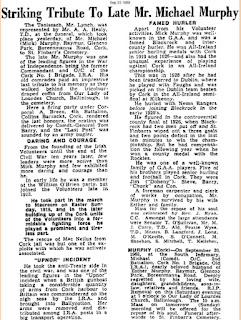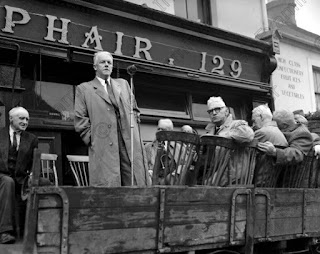General Tom Barry lived in a flat with his wife Leslie Price de Barra above the Woodford Bourne stores at 64 St Patrick Street from the 1940s until their deaths in the 1980s.
The flat above what is now McDonalds was once the home of Tom Barry and his wife Leslie Price.
Tom Barry was the formidable leader of the famous Third West Cork Brigade during the War of Independence and the Anti-Treaty IRA in the Civil War. Leslie was a veteran of the 1916 Rising and director of Cumann na mBan during the War of Independence.
Leslie & Tom in their later years.
In the years after the War of Independence and Civil War, Tom Barry fell into a number of important roles. In 1927 he was appointed General Superintendent at the Cork Harbour Commission, a role he held until 1965.
He remained active in the Republican movement, in 1934 he was imprisoned for a few months on arms possesion and in 1936 he was involved in the botched kidnapping of Admiral Somerville in Castletownsend who was shot. It was claimed Somerville was recruiting local lads to the British Navy but in his later years Barry stated the whole thing was a mistake.
Tom Barry remained an active Republican and was often at the fore of protests and events.
Woodford Bourne 1940s
In 1937 he became Chief of Staff of IRA but, it was a brief role as he clashed with those who supported a bombing campaign in Britain and he resigned his post.
The Woodford Bourne building.
During WWII Tom Barry was appointed to head of intelligence in the southern command of the Irish Defence Forces. Leslie became chair of the Irish Red Cross and was instrumental in helping orphans and refugees from Poland and Czechoslovakia.
Tom Barry and his wife Leslie lived in the flat of the top left window.
Tom Barry wrote articles for the Irish Defence Forces magazine which he would then mould into his famous memoir Guerilla Days in Ireland, which he wrote in his home overlooking Daunt Square. The book was released in 1949 and has never gone out of print. One such fan was Che Guevara who wrote to Barry at 64 Patrick Street in the 1960s asking him to join him in South America to train guerilla fighters, but Barry refused!
The first edition, 1949.
1956 edition
1960s edition
1980s edition
During the 60s and 70s Tom Barry was in high demand to speak at commemorative events and unveil memorials. He was vital in keeping the memory of the fight for freedom alive by making sure memorials were erected and events were held.
Tom Barry unveiling the memorial stone to Michael Collins at Sam's Cross 1965.
While her husband was busy keeping the memory of his comrades alive, Leslie helped launch the charity Gorta and helpled set up the Voluntary Health Insurance Company.
The instantly recognisable figure of General Tom Barry on one of his saunters.
When not attending commemorations and giving orations, Tom Barry was a familiar figure on the streets of Cork sauntering from his home down towards the Mardyke and around Fitzgerald's Park.
Bust of General Barry in Fitzgerald's Park where he was often seen walking.
General Tom Barry died in 1980 at the age of 83 and was buried near the Republican plot in St Finbarrs Cemetery. Leslie died four year later at the age of 91 and was laid to rest with her husband.
Funeral of Tom Barry 1980.
Grave of the revolutionary couple at St Finbarrs Cemetery Cork.
https://youtu.be/QobuRoXfL_0
Youtube - Interview with Tom Barry at his home in the late 1970s.











































































